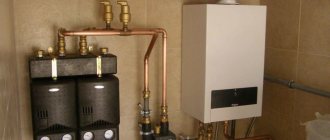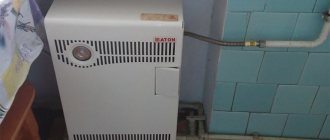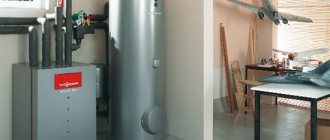Hot water is one of the most important components of comfort for those living in an apartment or private house. Many users can't stand the frequent outages and end up installing a storage or instantaneous water heater. One such option is gas-powered flow devices. Compared to electric ones, they are more economical, easier to maintain and operate. The rating of instantaneous gas water heaters, compiled based on reviews from real users, will help you choose the right device.
Types of gas storage water heaters
The following types of units are distinguished:
- With open camera. For stable operation, you need the equipment of a separate boiler room and chimney. The device takes oxygen from the room in which it is located.
- With a closed combustion chamber. The air needed to support the process comes from outside. A pump is used for this. It is also used to remove combustion products. It is necessary to ensure high-quality ventilation.
Water heaters can be floor-mounted or wall-mounted.
Variations of water heating equipment
Water heaters are classified into the following groups:
There are boilers with a built-in water heater. A copper tube is mounted in them, which is a spiral.
A homemade water heater, if professionally assembled, can last 5 years or more. Moreover, its price is an order of magnitude lower than that purchased in a store. The electricity consumption for operating homemade water heaters is minimal, and the heating time is comparable to the factory equivalent. Creating an electric water heater yourself is a completely realistic idea. Such homemade products can be used both in country houses and in residential apartments.
The device and how the unit works
The appliances are not used for heating, but exclusively for heating water. For those who are planning to install a unit of this type, the operating principle of gas storage equipment is important.
First, the heat exchanger is heated, then the temperature of the liquid increases. The first is placed inside a metal tank made of a steel alloy (but the inner surface may be enameled).
The operating principle of a gas water heater.
The heat exchanger is a coil made of steel, cast iron or copper. It is heated by a gas burner. The design of the device also assumes the presence of pipes for water outlet and supply, and heat-insulating elements. A gas storage water heater must include a chimney.
The device is equipped with an ignition system and sensors that monitor the temperature and pressure in the system.
Rating of TOP 10 best models
| Place | Name | Price |
| TOP 10 best instantaneous gas water heaters | ||
| 1 | Zanussi GWH 10 Fonte | 6 500 ₽ |
| 2 | Zanussi GWH 12 Fonte | 8 000 ₽ |
| 3 | Electrolux GWH 11 PRO Inverter | 13 000 ₽ |
| 4 | Electrolux GWH 10 NanoPlus 2.0 | 11 000 ₽ |
| 5 | Zanussi GWH 10 Fonte Glass La Spezia | 6 500 ₽ |
| 6 | Bosch WR 10-2P23 | 11 000 ₽ |
| 7 | Zanussi GWH 10 Fonte Turbo | 6 500 ₽ |
| 8 | Zanussi GWH 10 Fonte LPG | 6 000 ₽ |
| 9 | Electrolux GWH 12 NanoPlus 2.0 | 11 000 ₽ |
| 10 | Gorenje GWH 10 NNBW | 7 000 ₽ |
How to calculate the power of the device
The technical documentation contains the necessary information. But we can assume that a unit with a power of 23-24 kW allows heating about 14 liters per minute. This is enough for 2-3 water consumption points if a family of 3 lives in the house.
Units with a power of over 26 kW are suitable for large houses with more than 4 people.
The volume of the boiler is calculated depending on the number of consumers.
Safety
It is imperative to ground the boiler.
Any water heater, regardless of model and type, requires compliance with operating conditions, as well as safety precautions. Gas models have an increased danger, as there is a risk of gas leakage.
Contact with water is the main risk factor when operating any electrical product. The boiler is equipped with an automatic shutdown system upon contact with liquid, but this does not negate compliance with the simplest fire and electrical safety requirements.
It is important to make grounding in advance. Installation of a grounding wire is a basic and mandatory condition for the safety of an electrical appliance.
What breakdowns can happen and how to fix them
Troubleshooting should be carried out by qualified personnel. You cannot do repairs yourself, otherwise the device will be void of warranty. The only thing allowed is to replace the batteries in the automatic electric ignition system.
The piezoelectric element or the power cable may fail, but it is not recommended to replace them yourself.
Sometimes the equipment does not work because the ventilation needs to be cleaned, then you should call a technician. This also applies to washing filters and replacing membranes.
Sometimes the water heater does not turn on due to insufficient water pressure. To fix the problem, you need to set the flow control knob to the appropriate position.
Reviews
Technical characteristics are, of course, a key, but far from the only factor determining the choice of a storage gas water heater. In addition to dry numbers, it is also recommended to take into account the opinions of those who already use gas boilers. By reading reviews from real customers, you will learn how this or that model performs in practice, and not in the promises of sellers.
When studying reviews, you should pay attention to common breakdowns - it is from them that you can calculate the “weak points” of different models and manufacturers. You can get acquainted with reviews of Internet users on thematic forums or on the pages of various stores selling gas water heaters.
This is interesting: Safety valve for a boiler: design features + installation instructions
Criteria for choosing a storage type gas boiler
When purchasing equipment, consider the following points:
- Power and performance. The higher the indicators, the higher the maximum volume of water heated per unit of time.
- Tank material and heat exchanger. Steel coated with a layer of enamel is quite strong and durable, but inferior to stainless steel. However, the latter is more expensive and more susceptible to pressure changes. The most expensive and durable heat exchanger is considered to be copper.
- Ignition type. Models with a piezo element are considered a good option. To turn them on, just press a button. More expensive devices are equipped with electronic ignition. This system starts the water heater automatically when the tap is open.
A semi-automatic gas water heater with piezo ignition allows you to regulate the flow of gas into the water heater.
Volume calculation
To use a water heater conveniently, you need to choose the right equipment.
To calculate the volume of water in the storage tank, the following factors are taken into account:
- Number of consumers.
- Number of water intake points.
- The order of bathing procedures.
For example, if a family of 3 people lives in a house and there are 3 points of consumption, and there is no bath (there is only a shower), then the minimum volume for them is 80 liters, but it is better to take a 100 liter boiler
.
The best manufacturing company
Many brands have good models, for example:
- Electrolux. The instantaneous water heater NanoPlus 2.0 is popular. Open combustion chamber type. The heat exchanger is made of copper.
- Ariston. A good unit is the Ariston SGA 200. Power - 8.65 kW. Heat exchanger material is steel. The inside walls of the tank are covered with enamel. The model is equipped with piezo ignition.
- Baxi. A good device in the line is the SAG3 100. It is designed for a volume of 100 liters. With a power of 4.5 kW, the equipment has a productivity of 9.7 l/min. The heat exchanger is made of stainless steel. The tank is covered with titanium enamel. Built-in piezo ignition.
The gas water heater SAG-3 100 BAXI is suitable for domestic and industrial use.
Gas or electricity?
The age-old question: what fuel should I use to heat water? In apartments there is usually only talk about gas and electricity.
It is estimated that hot water from a gas water heater is several times cheaper than water heated by electricity. In addition, such equipment usually costs less. But expensive and complex installation (not only a gas project is required, but also its approval) prevents their mass distribution.
You can install an electric heater without any problems. But heating water will be much more expensive, and besides, the heating power itself will be greatly limited by the capabilities of the electrical wiring - it can simply knock out plugs.
Take your choice of gas equipment seriously. Firstly, the power of the device should be enough for constant comfortable use. Secondly, these characteristics will be specified during the development of the project. After its approval, simply changing the model to a more powerful one will not work - you will need to make changes and coordinate them with the gas service.
conclusions
Gas water heaters are great for heating hot water. They are used for both domestic and industrial needs in the presence of main or liquefied gas. There is a wide selection of types of heaters - the market offers an assortment of both domestic and foreign manufacturers of this equipment, each of which has a wide model range. Among their undoubted advantages is independence from voltage fluctuations in the electrical network (which happens quite often in our conditions, especially outside the city), efficiency and autonomous provision of hot water to a house or apartment. You should only buy gas heaters in new condition, checking for all certificates and permits - if you get a fake, the cost of inattention can be too high, because it can lead to a dangerous situation. The installation of equipment should also be entrusted to specialists, after first familiarizing yourself with their licenses and work permits, because if the equipment is installed by non-specialized workers, the warranty on the purchased product will automatically expire.
Principle of operation
Since the instantaneous boiler operates with high power, reliable wiring is required for connection. The standard connection is made with a three-core cable, where L is phase, N is zero, E is ground.
After turning on the equipment, electricity is supplied to the flow sensor. If the water pressure in the system is sufficient, the sensor closes the contacts. Then the heating element relay is activated and heating starts. Thermal sensors turn on in case of overheating. The circuit is completed by a light bulb on the panel, which lights up while the boiler is operating.
Here is a detailed diagram of the device:
Features of the models
Models of different brands may differ according to several criteria.
Heating element type:
- Open - consists of a plastic case with a spiral inside. When power is applied, the coil heats up and transfers heat to the passing flow.
- Closed - the operating principle is the same, only the spiral is enclosed in a body made of brass or copper. It is more fireproof.
Control:
- Mechanical (hydraulic) type. Adjustable via switch and has 6 power settings. The system consists of a block and a membrane, which, when flowing, moves and pushes the shutdown button. The disadvantage of the mechanics is inaccuracy - it may not work if there is insufficient pressure.
- Electronic type. Contains a microprocessor and sensors. This precise system allows you to maintain the set temperature and also adjust the power to save energy.
Varieties:
- Closed type (pressure). Provides high pressure in pipes to serve multiple intake points. You can use the shower and faucet in the kitchen at the same time. In this case, the water temperature will not decrease.
- Open type (non-pressure). Connect to one fence point. They have a compact body, so they can be installed separately on a faucet or shower.
How it works
The flow-through model differs from a storage boiler in that the design does not have a tank for storing hot water. Cold water is directly supplied to the heating elements and comes out already heated through a mixer or tap.
Let's look at the example of a Termex instantaneous water heater:
As you can see, the electrical circuit of the heater is quite simple. All structural elements can be easily found and purchased if the device fails
Now let's move on to the second, no less important question - let's look at how an instantaneous water heater works
Operating principle
So, using the example of the Termex heater provided above, let’s look at its operating principle.
Connection to the electrical network is carried out with a three-core cable, where L is phase, N is zero, and PE or E is ground. Next, power is supplied to the flow sensor, which is activated and closes the contacts if the water pressure is sufficient for operation. If there is no water or the pressure is very weak, the heating will not turn on, for safety reasons.
In turn, when the flow sensor is triggered, the power control relay is activated, which is responsible for turning on the heating elements. Temperature sensors, which are located further in the electrical circuit, are designed to turn off the heating elements when they overheat.
In this case, the temperature sensor T2 turns on after the heating elements cool down in manual mode. Well, the last element of the design is a neon indicator that displays the process of water heating.
That's the whole operating principle of an instantaneous electric water heater. If the device suddenly fails, use this diagram to find the faulty element.
Other models may have a modified operating scheme, for example, there will be a thermostat, as in the image below.
When cold water is supplied, this membrane moves, thereby pushing the activation lever through a special rod. If the pressure is weak, the displacement will not occur and the heating will not turn on.











